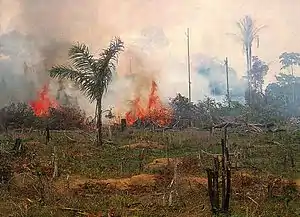Deforestation in the Democratic Republic of the Congo
Deforestation in the Democratic Republic of the Congo (DRC) is a significant transnational issue. In the DRC, forests are cleared for agricultural purposes by utilizing slash and burn techniques.[4]
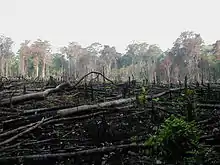 Slash and burn deforestation in southern Mexico to clear land for agriculture | |
| Country | Democratic Republic of the Congo |
|---|---|
| Location | Congo Basin |
| Forest type | Rainforest |
| Forest area | 154,000,000 ha or 595,000 sq mi |
| Deforestation rate | 311,000 ha or 1,200 sq mi annually; 0.2%[1] |
| Main causes | Fuelwood and charcoal collection, artisanal and small-scale logging, industrial logging, clearing for agriculture, and road construction.[2][3] |
Aside from the visible depletion of resources, deforestation of the DRC also leads to a lost habit for the mountain gorilla among other rare species like the okapi, resulting in decreased biodiversity, soil erosion, and contribute to climate change.
Since 1990 till 2015, the rate of deforestation in the DRC has remained constant at 0.20%, which equates to the loss of 311,000 hectares, or roughly 1,200 square miles, annually.[1] This amounts to destroying forests the size of Delaware every two years. The fact that the rate of deforestation has remained constant over more than twenty years is misleading as one might believe that government or non-government organizations (NGO) interventions have been responsible for the decline, but reports indicate otherwise. Three reasons have been postulated as to why deforestation rates had remained relatively low: 1) the road network within the country has been gradually in decline making access to more remote areas more difficult, 2) political and regulatory changes have disincentivized investment in the country, and 3) agriculture has expanded outside of forest areas.[5]
Additionally, while the rates remained constant, wood removal (measured in cubic meters) continues to dramatically increase annually. Industrialized roundwood has increased from 3.05 million cubic meters in 1990 to 4.45 million cubic meters in 2010; fuelwood has increased from 44.2 million cubic meters to 75.44 million cubic meters annually in that same time.[1]
From 2015 to 2019 the rate of tree-felling in the Democratic Republic of Congo has doubled.[6]
The rainforest in the Congo Basin is the largest rainforest in Africa and second only to the Amazon Basin in size, with 300 million hectare compared to the 800 million hectares in the Amazon.[1] Roughly fifty percent (154 million hectare) of the remaining rainforest in the Congo Basin lies within the boundaries of the DRC.[1]
The DRC is one of the most Flora rich countries on the continent.[7] It is home for more than 10,000 types of plants, 600 timber species, as well as 1,000 bird species, 280 reptile species, and 400 mammal species, including the forest elephant, gorilla, forest buffalo, bongo, and okapi. Many of these wildlife species are threatened animals such as large lowland gorillas and chimpanzees.[8] The deforestation destroys the biological diversity in the Congo Basin forest. Specifically, 60 percent of the forest elephant population drops due to the loss of shelter caused by illegal logging. [9]
Causes of deforestation
The direct causes of deforestation within the DRC are well understood and have been identified consistently by many sources.[2][3][10] The direct causes are as follows: 1) road infrastructure development, 2) slashing and burning the forests to transform forest land into agricultural land, 3) the collection of fuelwood and charcoal, and lastly 4) unregulated artisanal and small-scale logging. The United Nations Environment Programme has identified the priority in which the causes should be addressed as slash and burn agriculture first, the collection of fuelwood second, unregulated artisanal and logging third, and road infrastructure development fourth.[2]
Road construction
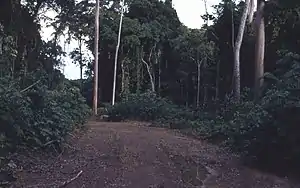
Both mining and logging create similar secondary deforestation through road construction. Specifically, logging companies construct new roads into previously inaccessible forest areas which facilitates the conversion of logged forests by into agricultural land.[10] This has led to the immigration of landless farmers, in particular from eastern savanna regions, to enter primary forest areas through logging roads.[11]
Incoming farmers cause extensive land degradation in converting the natural forest into farmlands. Further, it has been suggested that increases in returns can lead to substantial increase in farm sizes and shortening of the fallow period, which in turn eventually leads to large-scale and severe natural forest area destruction.
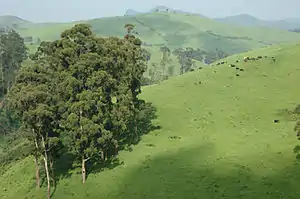
Transformation into agricultural land
The United Nations Environment Programme has identified slash and burn agriculture which produces reduced fall periods, as the most pressing issue related to the deforestation of the DRC.[2] This is the process of clearing land for agricultural use through burning the forest. This problem has deep roots as much of the DRC's population is dependent on this sort of slash and burn rain-fed agriculture for its sustenance. Practicing this style of intensive agriculture with short periods of soil rest leads to soil degradation and desertification.[3] This has resulted in increasing levels of food insecurity, and as much as 70 percent of the population of the DRC is estimated to be malnourished according to the Food and Agriculture Organization of the United Nations and World Food Programme.[2]
As the soil degrades and desertification occurs, farmers are forced to continually move farther out to find new land to farm which repeats the process all over again; thereby, farmers are exacerbating the clearing of natural forests. Furthermore, current farming practices are inefficient and unsustainable. When farmers move farther out to workable land, they are at the same time increasing the distance between themselves and markets where they can sell their produce. With almost no facilities for refrigeration, post-harvest crop losses can reach up to 80 percent.[2]
Currently the DRC is heavily reliant on imported food, which further places pressure on the forest lands to be cleared for agricultural purposes.[1] In 2010, the DRC's top import from the United States was meat, while they exported oil resources.[12]
Fuelwood and charcoal collection
Fuelwood and charcoal collection has been classified as a key driver for deforestation as it is used to account for 95% the population's energy needs.[2] The population's dependence on fuelwood for energy creates rings of fragmented forest around urban areas, which in turn calls for longer and longer forest excursions to supply a never ending demand for fuelwood.[5] The United Nations Environment Programme's Post-conflict Environmental Assessment Synthesis for Policy Makers reported that approximately 89 hectares of forest was lost each day due to illegal fuelwood harvesting during the peak of the post-Second Congo War conflict. It is estimated that 72 million m3 of fuelwood and charcoal are "produced" annually.[2]
Charcoal, or Makala, is inefficient to produce but is a preferred source of energy in the DRC. While it is virtually free to use fuelwood as a source of energy, charcoal increases in popularity as an energy source due to several advantages over fuelwood. Charcoal has higher calorific value per unit weight (31.8 MJ per kg) compared to fuelwood (16 MJ per kg); and charcoal is smaller and easier to store.[13]
Charcoal is also mostly smokeless and is not liable to deterioration by fungi or insects which attack fuelwood.[13] With these benefits, charcoal is particularly popular in cities. However, even in rural areas in Goma, North Kivu for example, charcoal is also widely used. On average, each person uses 1 to 1.6 cubic meter of fuelwood and 80 to 95 kg of charcoal annually.[14]
Regardless of the purposes, commercial or personal, fuelwood and charcoal are mostly collected by women and children in most regions in Africa.[14] The price of charcoal increases especially in large cities, such as Kinshasa, because vast amounts of forest are deforested close to the city and the cost of transportation increases as the distance of wood sources are farther away.
Artisanal
Artisanal logging in the DRC is characterized as logging activities without concession from the government at the national level.[15] Unregulated artisanal and small-scale logging is estimated to represent 75% of the total timber exports from the DRC and happens at a rate of 5 to 8 times greater than industrial logging.[2] However, this practice is still dwarfed in comparison to the total amount of wood being gathered annually for fuelwood and charcoal production, which happens at an amount 30 times greater than artisanal logging. There are three types of forest codes in the DRC—public institutions, private, and community forests. Artisanal logging takes place under community forest area.[15]
Community forests are owned by community chiefs or landlords who have the power to grant small-scale logging that are not regulated by the national government.[15] Many of these community owned forests where artisanal logging are located in the northeast part of the DRC. Artisanal logging is profitable but it is also deemed to be illegal. However, corruption in the local government allows the logging to continue.[15]
To perform artisanal logging, the logger needs to obtain permit from the local government. With approval by the community chief, loggers can obtain a permit; yet, they have to report the harvest to local forestry technicians. These local forestry offices are considered the appropriate entity for approving the logging permits while they do not have the capacity to conduct forest inventory and forest mapping.[15] Since the forest code does not have comprehensive mechanism to stop such logging activities, loggers continue to purchase logging rights from the local community. Depending on the scale of the logging, the community would demand different types of payment from loggers. One community in the North Kivu area, they demanded the logger to give them a 4x4 truck and upgrade the public infrastructures, which are not well provided for by the local government. Although the logger did not accept the request, this illustrates why locals want artisanal logging to exist.[15]
Although artisanal logging provides some income for the community in the short-run, it ultimately does not improve local living conditions. In the end, the communities receive payments which are not large enough to cover the loss of their natural resources. Since there is no monitoring mechanism, the loggers report lower harvested amounts than they actually do in order to pay less tax to the local government. Some loggers cut one tree within the woods and leave the rest intact to mimic natural disturbance.[15] To improve the situation, the DRC government needs better monitoring and better forest code to manage the logging activities.[16]
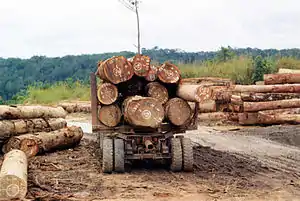
Industrial
Relative to agricultural land transformation, fuelwood and charcoal collection, and artisanal collection logging, industrial logging has a minor direct impact on forest destruction in the DRC in recent years due to the collapse of local markets in the early 1990s. However, logging has significant indirect effects as mentioned previously because of the roads constructed for it. The collapse of the logging industry in the 1990s has changed the industry into one of selective logging where only very large trees of high value are being extracted for export.[17]
As of 1999, 87% of the total volume of wood harvested was one of five species of African mahogany.[17] These selective logging practices yield only 8.7 cubic meters (the volume less than that of one tree) per hectare. This creates a scenario where many roads are created to move very few selected trees from the forest.[18] This creates access to previously secluded areas which expedites the rate of forest accessibility thereby allowing populations to move in to collect fuelwood, hunt bushmeat, and start clearing the land for agriculture.
It is important to consider who is driving the demand for industrial logging operations within the DRC and the sustainability of the industry. Currently in the DRC, it is estimated that as much as 80% of all timber that is officially exported by the DRC heads to the European market.[19] The majority of the exports are shipped to Portugal, Germany, and France.[18] Thus, it is not surprising to see that historically the largest forest concession owner in the DRC had been a German company, Danzer, which held 2.1 million hectares of the active concessions which total 8.2 million hectare[18] (recently this company's subsidiaries who held the logging concessions was sold the American-based Groupe Blattner Elwyn (GBE)).[20]
When looking at the sustainable practices of the large logging companies in the DRC, they are less than sustainable. According to the Forest Stewardship Council (FSC), a leader in certification for sustainable forestry practices, GBE will not be pursuing FSC certification for their practice in the DRC.[21] In addition to the country's major logging companies not pursuing sustainable logging practices, it is common place for logging to take place illegally within protected forest areas.[18]
A report by Forests Monitor and Rainforest Foundation published in 2007 [22] found that there is little evidence that industrial logging alleviates poverty, but instead actually contributes to it. This is mainly due to access to forest areas becoming restricted and money not filtering down to local people. "Keeping in mind that the Law only provides for conservation of 15% of the DRC’s forests and that more than 40% are earmarked for commercial logging, we still do not know what percentage of Congolese forests are to be returned back to the indigenous communities to enable them to practice their cultural and socio-economic activities" (Byayuwa).
Industrial logging concessions stop indigenous people having access to their forests, which they traditionally rely on for their livelihood through NTFPs (non-timber forest products, such as food products, plants of medicinal value, fuelwood and fallow fields). In addition to the restricted access to these resources, there are other damaging effects caused by the damage to the water courses that logging can create, which cuts fish resources and water that could be used for crop irrigation.
Industrial logging brings a lot of people in to the area to work for the logging companies, who are often given only short-term contracts. Once these contracts are finished, they then have to find new jobs in the area. This influx of logging workers can create competition for bushmeat resources. For locals who do get jobs with the logging companies, the working conditions can be bad and the pay low, some paying only 50 US cents a day.
Consequences of deforestation
Climate change
There are two ways that deforestation can cause changes in climate – by changing greenhouse gas emissions and eco-climate impact, or by changing the eco-service patterns, in this case, rainfall. Forests are sinks for carbon. Rainforest, in particular, hold great amounts of carbon with their complex and robust ecosystems. Forest within the DRC currently hold 17 million tons of carbon, which is the largest stock in Africa.[23]
Reductions to this carbon amount are occurring as a result of deforestation. When considering a business-as-usual (BAU) scenario of the development in the DRC, using current demographic and socioeconomic development trends, future environmental impacts caused from land degradation and deforestation can be evaluated. Researchers estimated that in the BAU scenario deforestation will claim 12-13 million hectares by 2030 which equates to 149 Million tons (Mt) of CO2e not being treated. And due to deforestation, the net annual emissions will grow from 71 Mt CO2e in 2007 to 149 Mt CO2e by 2030.[24]
Further, research has demonstrated that increased replacement of tropical rainforest vegetation with savanna grasslands can produce undesired climate changes in Africa. Forests are also providers of rainfall. The destruction of forest prevent such eco-services and lead to change in landscape. In areas that are heavily deforested, rainfall can decrease throughout the year; and specifically if over deforestation occurs in southern Africa, it may result in increased rainfall in the southern region of the DRC.[25]
This intensifies the loss of topsoil, prevents tall plants from growing back (changing the landscape permanently), and furthers the eco-climate change pattern. Naturally, this change does not only affect plant life but animals as well. Researchers have also begun running simulations to predict future conditions and concluded that great biodiversity loss will result if the DRC continues its current deforestation patterns. The Salonga National Park, for example, stands to lose around 7 species of mammals by 2050, and 19 species by 2080 if the DRC population do not reduce their heat-trapping emissions which result from deforestation.[26]
Bushmeat
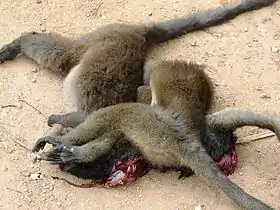
While road access has been shown to increase land clearing for farming, it also has other indirect yet significant implications for hunting and the bushmeat trade. Bushmeat refers to wildlife that live in the forest. In Africa, the forest are often referred to as "the bush", thus creating the term bushmeat. Bushmeat may include any sort of animal that lives in the forest that is hunted for its meat. In the DRC, the majority of bushmeat consists of artiodactyla species and make up almost 90% of all bushmeat trade. After artiodactyla species, primates consist of the next largest group at about 5% of all traded bushmeat.[27]
Even elephants which are known for being hunted for ivory are considered targets for bushmeat trade as a single elephant can provide thousands of kilos of meat which can be easier to sell than its ivory.[28] From 2002 to 2013, the DRC elephant population decreased dramatically from roughly 62,000 to 5,000.[2][29] In the DRC, with the wide expanses of forest, high income can be obtained from the meat trade; consequently, almost no sort of wildlife protection enforcement can prevent the consumption and trade of bushmeat, which continues to rise.
Road construction from logging and mining operations decreases the distance hunters have to walk to reach a given section of the forest to hunt, making what was previously a multi-day trip possible to complete within a day.[10] Additionally it has been shown that as logging increases, wages and demand for bushmeat increases as well; this leads to the increased export of bushmeat from the forest.[5][10]
Further, loggers themselves consume high amounts of bushmeat, eating it at a rate of two to three times more often than rural families who eat bushmeat roughly two days per week.[27] Logging also allows hunters to kill many more animals on each hunting trip as the hunters no longer need to carry the dead animals such long distances as logging vehicles can transport the animals.[30]
Currently, it is reported that over 1.7 million tonnes of bushmeat are consumed each year in the DRC at an estimated value of over US$1 billion.[2] The bushmeat trade, besides having a direct effect on the animal populations which are being hunted, has disastrous effects on the ecosystem as a whole. Depletion of animal populations directly threatens the ability for some of the larger forest carnivores. Additionally, decreases in the populations of seed-dispersing animals directly affects tree regeneration rates, forest structure, and composition.[27]
Soil erosion
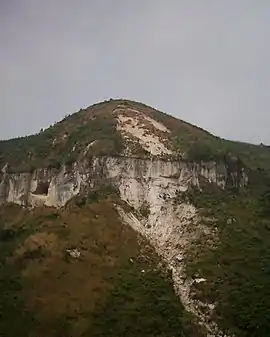
Soil erosion happens in the deforested areas of the DRC, which are mostly in the southern part of the country; and it is most intense in populous cities such as the capital Kinshasa, territory of Luberu, and the surroundings of Kasenyi near southern Lake Albert. Soil erosion has a mixture of causes, including mismanagement of land, climate change, intensive agricultural practice, and lack of adequate protection infrastructure/maintenance for soil.[3]
Land mismanagement is a substantial problem in the DRC and contributes to soil erosion. The cities in DRC have not adopted any new urban plans for decades[31] and now many cities are facing fast urban sprawl which is a major contributor of the deforestation in these areas (via fuelwood and charcoal collection).[2] The city of Kinshasa, for example, is still using the physical environment created from the colonial era but it now has a population of more than 10 million people.[31]
Urbanization is typically associated with more opportunities for employment and economic growth. This is not the case in Kinshasa and other cities in the DRC which are experiencing population stress largely due to migrant refugees coming from the armed conflict zones in the east.[32] As noted by Nelson Mandela, former president of South Africa, the only region in the world where urbanization is associated with negative economic growth in the world is Sub-Saharan Africa.[31]
Due to inadequate infrastructure to accommodate their surging population, informal settlements on the outskirts of the cities are being formed.[32] Many refugees deforest the unexplored land and build squatters settlements, or slums, on the steeps, exploiting many hilly areas.[32] Development of these hilly lands not only increase the rate of erosion but also put the inhabitants vulnerable to the risk of landslide, adding factors of insecurity to the already underprivileged community.[31] Although these settlements are illegal, the government does not have the will nor power to form urban plans, strategies to stop people from migrating, or to regulate the migrants' behavior.[31]
Without formal sources of income, these communities practice slash-and-burn agriculture, resting the land only every 2 to 3 years, to make their ends meet.[31] With intensive agriculture, the lands are quickly depleted and desertified. Without letting the forest regenerate, farmers cut down new forests and in turn expand the amount of desertified land which is very prone to erosion.[3]
Although the problem of soil erosion in these city areas are known, little has been done to address the issue. Few small-scale projects have demonstrated an ability to help protect the integrity of the soil, but no scalable ones have been implemented due to lack of funding. Soil erosion is also considered such a serious matter that the International Atomic Energy Agency (IAEA) has sent agents to inspect the reactor in Kinshasa and concluded that soil erosion could soon threaten the safety of nuclear power plants.[33]
Landscape change can also alter weather patterns. The Congo basin used to be covered by rainforest, yet an expansion of savannah in Central Africa has extending the sandy soil area because of deforestation.[3] The generation of oxygen by forest are contributors to the rainfall system.[3] However, deforestation has disrupted the ecosystem services and created an eco-climate issue. The rainfall pattern in this area has been characterized as a heavy rain season and a severe dry season. The missing forest has intensified the already dichotomy climate, increasing the episodes of violent rainfall and extending the dry season.[34] With long dry spells, the vegetation in these areas can become sparse. This results in no soil protection during the rainy season and creates more soil erosion problems.
Response
Observers in neighboring countries have mixed feelings of the overall deforestation of the Congo Basin. Some fear of famine as "farmers prefer to cut trees down to make charcoal and sell it ... rather than wait two years to harvest a field of cassava".[35] Also as a result of deforestation, hunting has decreased locally as animals are forced to move to new areas. Yet, others view the deforestation as simply a means of survival. Selling firewood can bring the equivalent of $1000 each month for those farmers able to produce one hundred 15-kilo sacks which sell for approximately $10 in most areas.[35]
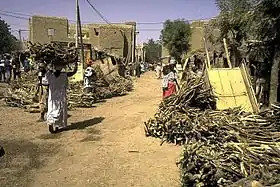
Within the DRC, the government has implemented initiatives such as the Agricultural and Rural Sector Rehabilitation Support Project (PARSAR). Yet corruption within the law enforcement sector of the government allows deforestation to continue. Laws have been passed to stop the wholesale demolition of the basin, yet bribes to government officials have been speculated as to the reason why little has changed. Additionally, most of the parties involved in the sale of wood and charcoal are former militiamen, which add elements of fear that a civil war might resume if their products were to be seized.[35]
The international community has taken an interest on this issue. On April 2, 2009, the World Bank's board of directors approved a grant targeted at improving the DRC's Ministry of Environment, Nature Conservation and Tourism to handle forest projects and increase collaboration between civil society, government institutions, and other stakeholders.[36] On July 14, 2011, the World Bank's board of directors approved a Global Environment Facility Trust Fund Grant of $13M to fund a project focused on strengthening the capacities of Congo Basin countries on reducing emissions from deforestation and forest degradation (REDD+) issues.[37]
The REDD campaign aims to extend the usage of ameliorated ovens to about 5 million urban households. Another way the government plans to address the issue of deforestation due to fuelwood is by providing electricity over certain territories to meet 60% of the needs by 2030.[24]
Private organizations such as Mercy Corps and WWF have begun to address the crisis in terms of fuelwood caused deforestation by introducing fuelwood plantations (such as the EcoMakala reforestation project[38]) as well as provide training for rural people to build fuel efficient cooking stoves (i.e. Goma Stove[39]).[2]
Certain organizations are looking into biomass briquette substitution in order to reduce the demand for fuelwood. Sustainable fuelwood production techniques are also being implemented. The EcoMakala reforestation project under the World Wildlife Fund (WWF) has pledged to reforest 4500 ha by 2012 to provide the people of Goma with fuelwood.[24] In the project, the trees are planted on soil belonging to local farmers, with the farmer's permission. The farmer hence becomes owner of the trees, and is able to make his own charcoal from these using a clamp. This amount of wood being planted to offset fuelwood collection is minimal when considering that over 300,000 ha of forest are destroyed each year alone. The REDD campaign is aimed at addressing climate change as all of it projects are working towards an overall world reduction in its emissions by approximately 17 Gt CO2e by 2020 in order to arrive at the GHG atmospheric concentration target of 445 parts per million (pm) of CO2e.[24]
While these efforts surely will help, they are by no means a solution to the problem. With citizens so dependent on fuelwood and charcoal for their energy basic needs (i.e. cooking) and livelihood, until the country is able to provide citizens with alternative sources of energy (i.e. electricity and alternative jobs[40]) the situation will likely not improve. Some jobs have recently become available through projects undertaken by the Virunga Alliance.[41] These include a hydroelectric plant, (Virunga Energies), a chocolate factory (Virunga Origins Chocolate) and a soap factory.[42][40] There is also chia seed factory nearby.[43][44]
Preliminary agreements have been reached between the Minister for the Environment of the DRC and the European Union Commission to launch a program named Forest Law Enforcement, Governance and Trade agreement (FLEGT).[45] This program aims to develop a system to improve the traceability and ensure legality of wood being imported to Europe. The use of independent observer programs of forest law enforcement and governance (IM-FLEG), carried out by organizations such as Resource Extraction Monitoring, can enhance the credibility of timber legality verification, and supports the efforts of those governments officially committed to cleaning up corruption in the sector.[46]
See also
- Mining industry of the Democratic Republic of the Congo since they need a large scale for them to mine they end up cutting the trees hence promoting soil erosion
- Fair trade cocoa
- Emmanuel de Merode
- Shea butter: alternative for palm oil
- BOS Foundation
References
- The State of Forests in the Amazon basin and Southeast Asian (PDF). Brazzaville, Republic of Congo: Food and Agriculture Organization of the United Nations (FOA). ISBN 978-92-5-106888-5. Retrieved 14 April 2012.
- United Nations Environmental Programme (2011). The Democratic Republic of the Congo: Post-Conflict Environmental Assessment (PDF). Nairobi, Kenya: United Nations Environment Programme. pp. Entirety. ISBN 978-92-807-3226-9.
- Iloweka, Ernest Manganda (2004). "The Deforestation of Rural Areas in the Lower Congo Province". Environmental Monitoring and Assessment. 99 (1–3): 245–50. doi:10.1007/s10661-004-4028-0. PMID 15641386.
- "Congo, Democratic Republic of the (DROC) - Environment Read more: Environment - Congo, Democratic Republic of the (DROC) -Environment". Encyclopedia of the Nations. Encyclopedia of the Nations. Retrieved 14 April 2012.
- Wolfire, Deanna; Jake Brunner; Nigel Sizer (1998). Forests and the Democratic Republic of Congo (PDF). Washington, DC: World Resources Institute. ISBN 978-1-56973-232-8. Retrieved 14 April 2012.
- Kinver, Mark (12 September 2019). "World 'losing battle against deforestation'". BBC News.
- Hart, Terese; Robert Mwinyihali (2001). Armed Conflict and Biodiversity in Sub-Saharan Africa:The Case of the Democratic Republic of Congo (DRC) (Report). Washington, D.C.: World Wildlife Fund. Retrieved 15 April 2012.
- Biodiversity and Forest Management in the Congo Basin (PDF). Montreal, CA: Secretariat of the Convention on Biological Diversity and Central African Forests Commission. 2009. ISBN 978-92-9225-152-9. Retrieved 15 April 2012.
- Butler, Rhett (23 January 2016). "Deforestation in the Congo Rainforest". Cite journal requires
|journal=(help) - Wilkie, David; Ellen Shaw; Fiona Rotberg; Gilda Morelli; Philippe Auzel (2000). "Roads, Development, and Conservation in the Congo Basin". Conservation Biology. 14 (6): 1614–1622. doi:10.1111/j.1523-1739.2000.99102.x.
- Witte, John (1992). "Deforestation in Zaire: Logging and Landlessness". Ecologist. 22 (2): 58–64. Retrieved 15 April 2012.
- "Democratic Republic of Congo". Office of the United States Trade Representative. Retrieved 15 April 2012.
- Malimbwi, Rodgers; Eliakimu M. Zahabu (2008). Woodlands and the charcoal trade: the case of Dar es Salaam City (PDF). Finnish Forest Research Institute. pp. 93–114.
- "Impacts of Charcoal and Fuel Wood Use in the Goma Region, North Kivu" (PDF). Forests Monitor. Archived from the original (PDF) on 22 February 2014. Retrieved 15 April 2012.
- Brown, Ellen; Jean-Remy Makana; Wildlife Conservation Society (2010). "Experience From a Pilot Project to Improve Forest Governance in the Artisanal Logging Sector in Northeastern Democratic Republic of Congo" (PDF). Retrieved 15 April 2012.
- Tegtmeyer, Reiner (2007). "DRC's forests: "towards satisfactory management and governance standards"?" (PDF). global witness. Archived from the original (PDF) on 23 February 2014. Retrieved 15 April 2012.
- Makana, Jean-Remy; Thomas, Sean C. (2006). "Impacts of Selective Logging and Agricultural Clearing on Forest Structure, Floristic Composition and Diversity, and Timber Tree Regeneration in the Ituri Forest, Democratic Republic of Congo". Biodiversity and Conservation. 15 (4): 1375–1397. doi:10.1007/s10531-005-5397-6.
- "Country Profiles - Democratic Republic of Congo". Forests Monitor. Archived from the original on 18 March 2012. Retrieved 15 April 2012.
- Heuse, Emmanuel. "The Congolese forest, governance and timber trade: FLEGT!". Belgian Development Agency. Retrieved 15 April 2012.
- "Danzer Group sells its operations in the Democratic Republic of Congo" (PDF). Danzer Group. Retrieved 15 April 2012.
- Baillie, Mike; Monica Davis. "Danzer sells its logging operations in the DRC — will its successor do any better?". Retrieved 15 April 2012.
- "Concessions to Poverty report". Forests Monitor & Rainforest Foundation. Archived from the original on 22 February 2014. Retrieved 19 December 2012.
- "The Democratic Republic of the Congo: Rainforests and Climate Change" (PDF). Friends of the Congo. Retrieved 15 April 2012.
- "The Democratic Republic of Congo's REDD+ Potential" (PDF). Democratic Republic of Congo Ministry of the Environment, Nature Conservation, and Tourism. 2009. pp. 1–62. Archived from the original (PDF) on 11 May 2012. Retrieved 15 April 2012.
- Semazzi, FHM; Song, Y (1 January 2001). "A GCM study of climate change induced by deforestation in Africa". Climate Research. 17 (2): 169–182. doi:10.3354/cr017169.
- "Salonga National Park, Democratic Republic of Congo". Climate Hot Map. Retrieved 15 April 2012.
- Central African Regional Program for the Environment. "#23 - Bushmeat Crisis Causes, Consequences and Controls". Biodiversity Support Program. Retrieved 15 April 2012.
- Stein, J.T. and BCTF. "BCTF Fact Sheet: African Elephants and the Bushmeat Trade" (PDF). Bushmeat Crisis Task Force. Archived from the original (PDF) on 23 September 2015. Retrieved 15 April 2012.
- Vera, Varun and Ewing, Thomas (April 2014) Ivory's Curse Born Free USA and C4ADS, Retrieved 17 May 2014
- Bushmeat Crisis Task Force (2000). "BCTF Fact Sheet: The Role of the Logging Industry" (PDF). Wildlife Conservation Society. Retrieved 15 April 2012.
- Eric, MM Nsokimieno; Chen Shouyu; Zhang li Qin (2010). "Sustainable Urbanization's Challenge in Democratic Republic of Congo". Journal of Sustainable Development. 3 (2): 242–254. ISSN 1913-9063. Retrieved 15 April 2012.
- Kachaka, Sudi K. "National Nile Basin Water Quality Monitoring Baseline Report for Democratic Republic of Congo" (PDF). University of Kinshasa. Retrieved 15 April 2012.
- "African Reactors Seen as 'Soft Targets' for Terrorists". Voice of America. 2002. Retrieved 15 April 2012.
- N'Dona, Alain. "Road Stabilization and Erosion Control Using the Vetiver System in the Democratic Republic of the Congo" (PDF). The Vetiver Network International. Archived from the original (PDF) on 4 April 2015. Retrieved 15 April 2012.
- Severin, Arsene (2010). "Deforestation Threatens South With Famine". Inter Press Service. Archived from the original on 1 January 2011. Retrieved 15 April 2012.
- World Bank - Operations Policy and Country Services (2010). "Status of Projects in Execution FY10: Africa Region - Congo, Democratic Republic of" (PDF). World Bank. Retrieved 15 April 2012.
- "Central Africa Forests Commission – Congo Basin Project". World Bank. 2011. Retrieved 15 April 2012.
- EcoMakala Project
- These handmade cookstoves save fuel—and help save gorillas
- Virunga: jobs protecting forests
- What is the Virunga alliance ?
- Sicovir soap factory
- Chia seed factory
- Compagnie des Produits Agricoles du Kivu
- "Fight against illegal timber exports: the EU and the Democratic Republic of Congo launch negotiations". European Commission. Retrieved 15 April 2012.
- "Independent Monitoring of Forest Law Enforcement and Governance (IM-FLEG)" (PDF). Resource Extraction Monitoring. Retrieved 30 November 2012.
